Spica was the star in the middle (Ana-roto). We could
then expect a position at the middle of the Sun year. However,
because of the precession midsummer must then have repositioned
Spica (and the other fixed stars) with around *202 (Spica) - *91 (June 21) = *111
right ascension days. Or perhaps rather with around *202 (Spica)
- *95 (June 24 = Day of St John) = *108 right ascension days.

The stars would gradually have been pushed later and later in
the tropical year. In myth this phenomenon was connected with
Raven:
... the bird, being sent with a cup for
water, loitered at a fig-tree till the fruit became ripe, and
then returned to the god with a water-snake in his claws and a
lie in his mouth, alleging the snake to have been the cause of
the delay. In punishment he was forever fixed in the sky with
the Cup and the Snake; and, we may infer, doomed to everlasting
thirst by the guardianship of the Hydra over the Cup and its
contents. From all this came other poetical names for our Corvus
- Avis Ficarius, the Fig Bird; and Emansor,
one who stays beyond his time; and a belief, in early folk-lore,
that this alone among birds did not carry water to its young
...
The fluid movements of the Serpent across the ground made this
creature ideal to compare with a stream of fresh water. This obvious correspondence
could be underlined by naming it a
'water-snake' (Hydra).
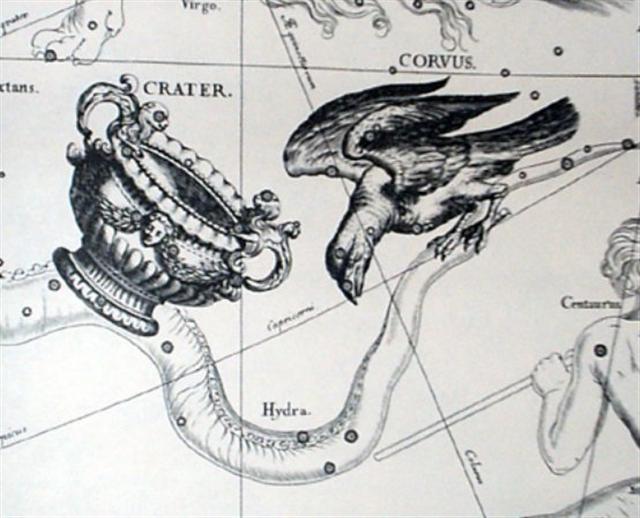
The Raven (Corvus) would once upon a time have been close to the Fig-tree →
midsummer.

In the picture above we can see the form of the Spear (harpoon) in the
center of the foliage of the Tree, with its head at the north pole, and
below the climbing Serpent (head up) curled like a
rope (vine) around the Pillar (stem) of the Tree.
... I became
curious about this star ... called Nuutuittuq [= 'never
moves'] ... So, on the lee side of our uquutaq (a snow
windbreak) I positioned a harpoon [vero] pointing
directly at this particular star to see if it would move. In the
morning I checked it and discovered that the Tukturjuit
(Ursa Major) had changed their position completely but the
harpoon still pointed at this star ... I had discovered the
stationary star
...
... I thrust in that stake under the deep
ashes, until it should grow hot, and I spake to my companions
comfortable words, lest any should hang back from me in fear.
But when that bar of olive wood was just about to catch fire in
the flame, green though it was, and began to glow terribly, even
then I came nigh, and drew it from the coals, and my fellows
gathered about me, and some god breathed great courage into us.
For their part they seized the bar of olive
wood, that was sharpened at the point, and thrust it into his
eye, while I from my place aloft turned it about, as when a man
bores a ship's beam with a drill while his fellows below spin it
with a strap, which they hold at either end, and the auger runs
round continually ...
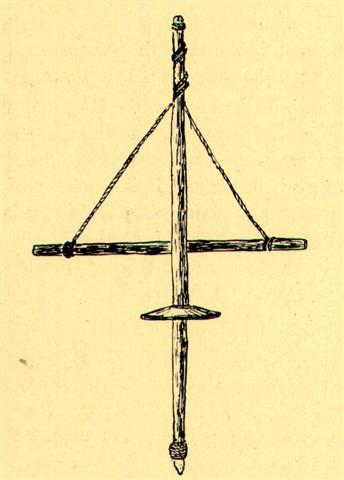
The Beak of the Raven (Alchita,
α Corvi) had always been at the Full Moon when
the Sun was at the Navel of the Horse (Sirrah, α Andromedae):
|
no glyph |
koia |
ki te
hoea |
ki te henua |
te rima te hau tea |
haga i te mea ke |
ki te henua -
tagata honui |
|
Ko. 1. Article (ko te);
preposition: with (see grammar); prefix of
personal pronouns: koau, I; kokoe, you
(singular); koîa, he, she, it; kokorua,
you (plural); ko tagi, koîa, he with his
weeping. 2. Article which precedes proper nouns,
often also used with place names: Ko Tori, Ko
Hotu Matu'a, Ko Pú.
Koîa, exact: tita'a koîa, exact
demarcation. Seems to be the personal pronoun
koîa - applied in the meaning of: thus it is,
here it is precisely. Vanaga. 1. Negative;
e ko, not, except; e ko ora, incurable;
ina ko, not; ina ko tikea, unseen;
ina e ko, not; ina e ko mou, incessant.
2. A particle used before nouns and pronouns; ko
vau, I; ko te, this; ko mea tera,
this; ati ko peka, to avenge, ko mua,
first, at first, formerly. 3. There, yonder. P Mgv.:
ko, over there, yonder. Ta.: ó, there,
here. Churchill.
Hoe. Hoe 1. Paddle. Mgv.:
hoe, ohe, id. Mq., Ta.: hoe, id.
2. To wheeze with fatigue (oeoe 2). Arero
oeoe, to stammer, to stutter; Mgv. oe, to
make a whistling sound in breathing; ohe, a
cry from a person out of breath. Mq.: oe, to
wheeze with fatigue. 3. Blade, knife; hoe
hakaiu, clasp-knife, jack-knife; hoe hakanemu,
clasp-knife; hoe pikopiko, pruning knife. 4.
Ta.: oheohe, a plant. Ma.: kohekohe,
id. Churchill.T. Paddle. E hoe te heiva =
'and to paddle (was their) pleasure'. Henry. Hoea,
instrument for tattooing. Barthel.
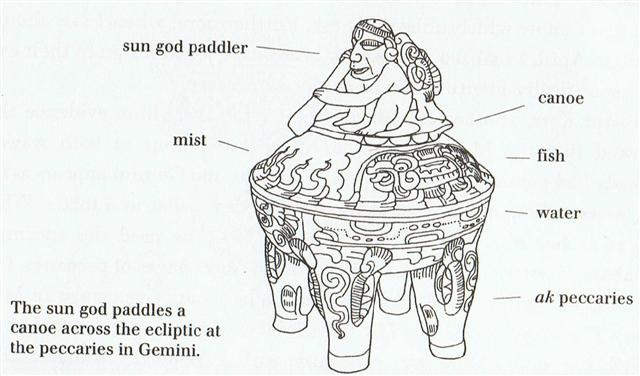 |
 |
 |
 |
 |
 |
 |
|
Ca1-1 |
Ca1-2 |
Ca1-3 |
Ca1-4 |
Ca1-5 |
Ca1-6 |
|
CLOSE TO
THE SUN: |
|
Sept 20
(263) |
21 |
Equinox |
23 |
24 |
25 (84 + 184) |
26 |
|
ALCHITA
= α Corvi,
MA
WEI (Tail of the Horse) = δ Centauri
(183.1),
MINKAR = ε Corvi
(183.7), ρ Centauri (183.9) |
PÁLIDA (Pale) = δ Crucis
(184.6),
MEGREZ
(Root of the Tail) = δ Ursae Majoris
(184.9) |
Hasta-13 (Hand) /
Chariot-28 (Worm)
GIENAH
(Wing) = γ Corvi
(185.1),
ε
Muscae (185.2),
ζ
Crucis (185.4),
ZANIAH
(Corner) = η Virginis
(185.9)
*144.0 = *185.4 - *41.4 |
CHANG SHA
(Long Sand-bank) = ζ
Corvi
(186.3) |
INTROMETIDA (Inserted)
=
ε
Crucis
(187.4),
ACRUX =
α
Crucis
(187.5)
*146.0 =
*187.4 - *41.4 |
γ
Com. Berenicis (188.0),
σ
Centauri (188.1),
ALGORAB = δ Corvi
(188.5),
GACRUX = γ Crucis
(188.7) |
γ
Muscae (189.0),
AVIS SATYRA (Bird of the Satyrs) = η Corvi
(189.3),
ASTERION (Starry) = β Canum Ven.
(189.5),
KRAZ = β Corvi,
κ Draconis (189.7) |

... Raven gazed up and down the beach. It was
pretty, but lifeless. There was no one about to
upset, or play tricks upon. Raven sighed. He crossed
his wings behind him and strutted up and down the
sand, his shiny head cocked, his sharp eyes and ears
alert for any unusual sight or sound. The mountains
and the sea, the sky now ablaze with the sun by day
and the moon and stars he had placed there, it was
all pretty, but lifeless. Finally Raven cried out to
the empty sky with a loud exasperated cry. And
before the echoes of his cry faded from the shore,
he heard a muffled squeak. He looked up and down the
beach for its source and saw nothing. He strutted
back and and forth, once, twice, three times and
still saw nothing. Then he spied a flash of white in
the sand. There, half buried in the sand was a giant
clamshell. As his shadow fell upon it, he heard
another muffled squeak. Peering down into the
opening between the halves of the shell, he saw it
was full of tiny creatures, cowering in fear at his
shadow ... |
|
CLOSE TO THE FULL
MOON: |
|
March 21
(80)
Al Fargh al Thāni-25 (Rear Spout)
0h (365.25)
CAPH
(Hand)
= β Cassiopeiae,
SIRRAH (Navel of the Horse)
=
α
Andromedae
(0.5),
ε
Phoenicis,
γ³
Oct.
(0.8) |
22
Uttara Bhādrapadā-27 (2nd of the Blessed Feet) /
Wall-14 (Porcupine)
ο Oct. (1.3),
ALGENIB PEGASI = γ Pegasi
(1.8) |
23
χ Pegasi (2.1), θ Andromedae (2.7) |
24
σ
Andromedae (3.0), ι Ceti (3.3), ζ Tucanae (3.5), ρ
Andromedae, π Tucanae (3.7) |
3-25
Julian equinox
no
star listed (4) |
26 (80 + 5)
ANKAA
= α Phoenicis,
κ Phoenicis (5.0)
ALPHARD (α
Hydrae)
|
27
λ
Phoenicis (6.3), β Tucanae (6.4)
*6.4 -
*41.4 + *366.0 = *331
= *148.0 +
183.0 |
|
... Nut, whom the Greeks
sometimes identified with Rhea, was goddess of the
sky, but it was debatable if in historical times she
was the object of a genuine cult. She was Geb's twin
sister and, it was said, married him secretly and
against the will of Ra. Angered, Ra had the couple
brutally separated by Shu and afterwards decreed
that Nut could not bear a child in any given month
of any year. Thoth, Plutarch tells us, happily had
pity on her. Playing draughts with the Moon, he won
in the course of several games a seventy-second part
of the Moon's light with which he composed five new
days. As these five intercalated days did not belong
to the official Egyptian calendar of three hundred
and sixty days, Nut was thus able to give birth
successively to five children: Osiris, Haroeris
(Horus), Set, Isis and Nepthys ... |
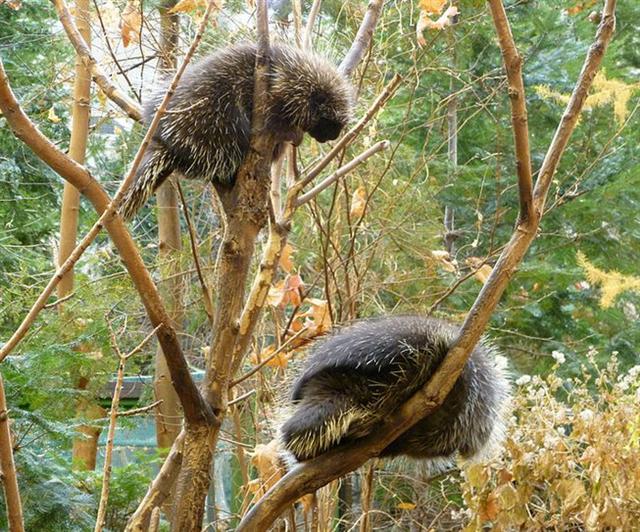
... The players
all played at once, without waiting for turns,
quarreling all the while, and fighting for the
hedge-hogs; and in a very short time the Queen was
in a furious passion, and went stamping about, and
shouting 'Off with his head!' or 'Off with her
head!' about once in a minute. Alice began to feel
very uneasy: to be sure, she had not as yet had any
dispute with the Queen, but she knew that it might
happen any minute, 'and then', thought she, 'what
would become of me?' They're dreadfully fond of
beheading
people here: the great
wonder is, that there's any one left alive! ... |
... There was no water in the village. The
lakes and rivers were dry. Raven and Crow, two young girls who
were having their first menstrual courses, were told to go and
draw water from the ocean. Finding the journey too long, Raven
decided just to urinate into her basket-bucket. She deceived no
one and was severly scolded.

Crow returned much later but with drinking
water. As a punishment, Raven was condemned never to find water
in the summer; only in winter would she find something to drink.
For that reason the Raven never drinks during the hot months;
she speaks with a raucous voice because of her dry throat ...
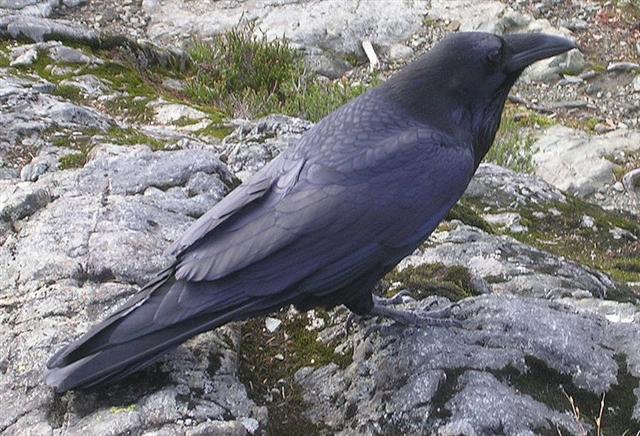
Crow had to go much farther, because the fresh sweet drinking
water was to be found half a year away in spring (spring water).
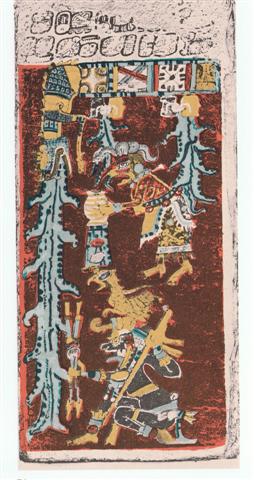
Probably the Tree alluded to the Southern Cross, where
Intrometida (Inserted) was to be found at the 'armpit', and
where Black Raven
was perceived at the opposite side of the pillar (stem) of the
cross (tree):
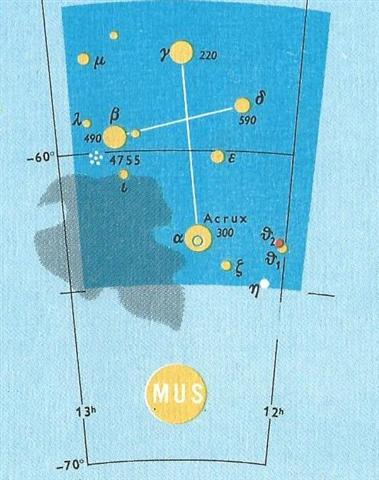
... He turned
round and round to the right as he fell from the sky back to the
water. Still in his cradle, he floated on the sea. Then he
bumped against something solid. 'Your illustrious grandfather
asks you in', said a voice. The Raven saw nothing. He heard the
same voice again, and then again, but still he saw nothing but
water. Then he peered through the hole in his marten-skin
blanket. Beside him was a grebe. 'Your illustrious grandfather
asks you in', said the grebe and dived. Level with the waves
beside him, the Raven discovered the top of a housepole
made of stone. He
untied himself from his cradle and climbed down the pole to the
lowermost figure.
Hala qaattsi
ttakkin-gha,
a voice said: 'Come inside, my grandson.' Behind the fire, at
the rear of the house, was an old man white as a gull. 'I have
something to lend you', said the old man. 'I have something to
tell you as well. Dii hau dang iiji: I am you.' Slender
bluegreen things with wings were moving between the screens at
the back of the house. Waa'asing dang iiji, said the old
man again: 'That also is you.'
The old man gave
the Raven two small sticks, like gambling sticks, one black, one
multicoloured. He gave him instructions to bite them apart in a
certain way and told him to spit the pieces at one another on
the surface of the sea. The Raven climbed back up the pole,
where he promptly did things backwards, just to see if something
interesting would occur, and the pieces bounced apart. It may
well be some bits were lost. But when he gathered what he could
and tried again - and this time followed the instructions he had
been given - the pieces stuck and rumpled and
grew to
become the mainland and Haida Gwaii
...
By combining a pair of wooden sticks in the
proper way (by inserting one into the other) the whole world could suddenly be perceived,
would suddenly come alive.
Thus, we can find e.g. Porrima and Spica not
far away:
| te ika |
te honu |
 |
 |
|
Ca1-7 |
Ca1-8 |
|
α Muscae
(190.2), τ Centauri (190.5), χ Virginis (190.7)
ALDERAMIN (α
Cephei)
|
Al Áwwā'-11 (The Barker) /
Shur-mahrū-shirū-18 (Front or West Shur)
SOMBRERO GALAXY = M104 Virginis
(191.1),
ρ
Virginis (191.4),
PORRIMA =
γ
Virginis,
γ
Centauri (191.5)
*150.0 =
*191.4 - *41.4 |
 |
|
ANDROMEDA
GALAXY (M31),
π Andromedae (7.7) |
ε Andromedae (8.2),
DELTA =
δ Andromedae
(8.4),
SCHEDIR (Breast) = α Cassiopeiae
(8.6), ζ Andromedae, μ Phoenicis (8.9)
*150.0
+ *183.0 = *333.0 = *8.4 - *41.4 + *366.0 |
 |
| te
manu te henua |
te Rei |
kua hakagana |
te henua |
honu |
te henua |
 |
 |
 |
 |
 |
 |
 |
|
Ca1-9 |
Ca1-10 |
Ca1-11 |
Ca1-12 |
Ca1-13 |
Ca1-14 |
Ca1-15 |
|
CLOSE TO
THE SUN: |
|
Sept 29 |
30 (3 *
91 = 273) |
Oct 1 |
2 |
3 |
4 (277) |
5 |
|
ι
Crucis (192.2),
β
Muscae (192.5),
MIMOSA
=
β
Crucis
(192.9) |
no star listed (193) |
κ
Crucis (194.4),
ψ
Virginis (194.5),
μ
Crucis,
λ
Crucis (194.6),
ALIOTH (Fat Tail)
=
ε
Ursae Majoris,
ι
Oct.
(194.8)
*153.0 = *194.4 - *41.4 |
MIN-EL-AUVA =
δ
Virginis
(195.1),
COR CAROLI =
α
Canum Ven.
(195.3) |
δ
Muscae (196.5) ,
VINDEMIATRIX (Grape Gatherer) =
ε
Virginis
(196.8) |
13h (197.8)
ξ¹ Centauri (197.1), ξ² Centauri (197.9) |
APAMI-ATSA (Child of Waters)
=
θ
Virginis,
ψ
Hydrae (198.5),
DIADEM
=
α
Com. Ber.
(198.9) |
|
'Sept
2 |
3 (246 =
2 * 123) |
4 |
5 |
6 |
7 |
8 |
 |
|
CLOSE TO THE FULL
MOON: |
|
March 30 |
31 |
April 1
(91) |
2 |
3 |
4 |
(460 =
365 + 95 |
|
ξ
Phoenicis (9.0),
ρ
Tucanae (9.1),
DENEB KAITOS (Tail of the Sea Beast)
=
β
Ceti,
η
Phoenicis (9.4),
AL NITHĀM (String of Pearls) =
φ¹ Ceti
(9.6)
*334.0 = *375.4 - *41.4 |
ACHIRD (Woman with Luminous Rays)
= η Cassiopeiae
(10.7) |
Legs-15 (Wolf)
ν
Andromedae (11.0),
φ²
Ceti (11.1),
ρ Phoenicis (11.2),
η
Andromedae
(11.4)
*336.0 = *377.4 - *41.4 |
CIH (Whip)
= γ Cassiopeiae,
λ Tucanae (12.4), φ³ Ceti (12.6), μ Andromedae
(12.8)
*337.0 = *378.4 - *41.4 |
φ4 Ceti (13.2) |
no star
listed (14) |
1h (15.2)
β
Phoenicis (15.1), υ Phoenicis, ι Tucanae (15.6), ζ
Phoenicis (15.7) |
|
'March 3 |
4 (63 = 9 * 7) |
5 |
6 |
7 |
8 |
9 |
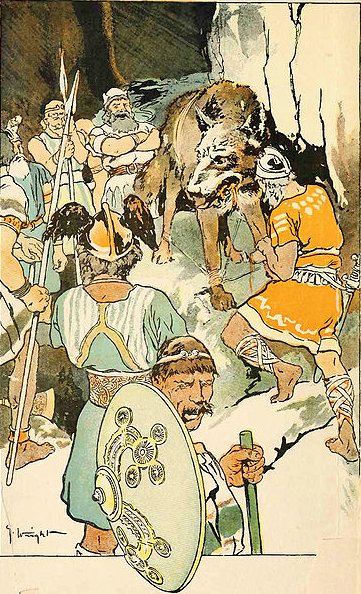 |
| koia ka hua |
koia ki te henua |
kiore kikiu - te henua |
te maitaki - te kihikihi |
hakaraoa - te henua |
 |
 |
 |
 |
 |
|
Ca1-16 |
Ca1-17 |
Ca1-18 (→ 4 * 29½) |
Ca1-19 |
Ca1-20 |
|
CLOSE TO
THE SUN: |
|
Oct
6 |
7
(280) |
8 |
9 |
10 |
|
AL
DAFĪRAH
(Tuft) = β Com. Ber.
(199.4)
*158.0 = *199.4 - *41.4 |
σ Virginis (200.4)
*159.0 = *200.4 - *41.4 |
γ Hydrae (201.0), ι Centauri (201.4)
*160.0 = *201.4 - *41.4 |
Al Simāk-12 (Lofty) /
Chitra-14 (Bright One) /
Horn-1 (Crocodile) /
Sa-Sha-Shirū-20
(Virgin's Girdle) /
ANA-ROTO-3 (Middle pillar)
MIZAR =
ζ
Ursae Majoris
(202.4),
SPICA
=
α
Virginis,
ALCOR
= 80 Ursae Majoris
(202.7)
SADALMELIK (α Aquarii)
*161.0 = *202.4 - *41.4 |
71 VIRGINIS
(203.6) |

... Mons Maenalus, at the feet of Boötes,
was formed by Hevelius, and published in his
Firmamentum Sobiescianum; this title
coinciding with those of neighboring stellar
groups bearing Arcadian names. It is sometimes,
although incorrectly, given as Mons Menelaus,
- perhaps, as Smyth suggested, after the
Alexandrian astronomer referred to by Ptolemy
and Plutarch. The Germans know it as the Berg
Menalus; and the Italians as Menalo.
Landseer has a striking representation of the
Husbandsman, as he styles Boötes, with sickle
and staff, standing on this constellation
figure. A possible explanation of its origin may
be found in what Hewitt writes in his Essays
on the Ruling Races of Prehistoric Times:
The Sun-god thence climbed up the
mother-mountain of the Kushika race as the
constellation Hercules, who is depicted in the
old traditional pictorial astronomy as climbing
painfully up the hill to reach the constellation
of the Tortoise, now called Lyra, and thus
attain the polar star Vega, which was the polar
star from 10000 to 8000 B.C. May not this modern
companion constellation, Mons Maenalus, be from
a recollection of this early Hindu conception of
our Hercules transferred to the adjacent Bootes? |
|
'Sept 9 |
10 |
11 |
12
(255 = 355 - 100) |
13 |
|
"Sept 26 |
27 |
28 |
29
(241 = 282 - 41) |
30 |
|
JULY
7 |
8 |
9 |
10
(191 = 282 - 64) |
11 |
|
138 |
139 |
140 |
141
= 282 - 141 |
142 |
|
CLOSE TO THE FULL
MOON: |
|
April 6
|
7 |
8 |
9
(365 + 99 = 464) |
10
(100) |
|
Al Batn Al Hūt-26 (Belly of the Fish) /
Revati-28 (Prosperous) /
1-iku (Field Measure)
MIRACH
(Girdle) =
β
Andromedae, KEUN MAN MUN (Camp's South Gate) =
φ
Andromedae
(16.0),
ANUNITUM
=
τ
Piscium
(16.5),
REVATI
(Abundant) =
ζ
Piscium
(16.9)
REGULUS
(α Leonis) |
ν Phoenicis (17.4), κ Tucanae (17.6)
*342.0 = *383.4 - *41.4
= *159.0 + *183.0 |
no star listed (18) |
ADHIL (Garment's Train)
=
ξ
Andromedae
(19.3),
θ
Ceti (19.7) |
KSORA
(Knee) =
δ
Cassiopeiae
(20.1),
ω
Andromedae (20.6),
γ
Phoenicis (20.8) |

... Though Andromeda has its
roots most firmly in the Greek tradition, a
female figure in Andromeda's place appeared in
Babylonian astronomy. The stars that make up
Pisces and the middle portion of modern
Andromeda formed a constellation representing a
fertility goddess, sometimes named as
Anunitum or the Lady of the Heavens ... |
|
'March 10 (*354) |
11 |
12 |
13 (437) |
3-14 |
|
"Febr 24 (*340) |
25 |
26 |
27 (423) |
28 |
|
FEBR 1 (*317) |
2 |
3 |
4 (400 = 365 + 35) |
5 |
|
321 |
322 |
323 |
324 = 464 - 141 |
325 = 142 + 183 |
|



























